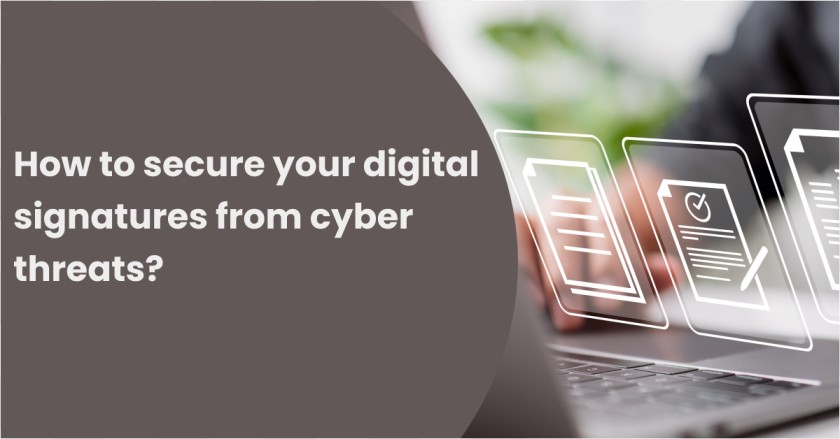In today’s business environment where businesses handle large volumes of sensitive data on a daily basis, digital signatures are an absolute necessity. They enable the users to safely sign documents and verify their identities online. Whether it is about signing a contract or approving a transaction, or submitting key documents, digital signatures bring in ease and speed. With cybercrime becoming a key concern in this digital world,the need of the hour is to protect digital signatures from malevolent attacks and cyberthreat. However, due to the growing use of digital signatures in both large and small companies, it is becoming increasingly difficult for the certification authorities to keep a tab on malicious activities. In this ultimate guide, we will bring to you the best practices and measures which you can adopt to secure your digital signature certificate.
Why it is important to safeguard your digital signature
The cybercriminals are coming up with innovatively dangerous schemes to find new victims on the internet. A corrupt digital signature can produce grave ramifications for you, such as identity theft, financial loss, and reputational damage. By ensuring that your digital signature is completely secure, you can protect your personal and business information, avoid financial setbacks, maintain the trust and confidence of your clients and partners and keep your name and reputation intact.
Common cyber threats to digital signatures
Prior to discussing the best ways to protect your digital signature, let’s examine some typical online dangers that could threaten its confidentiality and integrity.
- Phishing attacks: Phishing attacks use phony emails or websites to deceive people into divulging their digital signature credentials. Your digital signature may be accessed without authorisation as a result of these assaults, giving cybercriminals the ability to impersonate you and sign papers on your behalf.
- Malware and keyloggers: By recording your keystrokes and stealing your login information, malicious software and keyloggers can violate the security of your digital signature. This may make it possible for hackers to access your digital signature without authorisation and use it maliciously.
- Man-in-the-middle attacks: These happen when an attacker eavesdrops on your conversations with the provider of digital signatures. The integrity of your digital signature may be jeopardised and the attacker may be able to alter the communication.
- Forgery: Experts believe that it is a myth that the eSignatures can be forged. The truth is that cryptographic techniques used in eSignatures make them completely secure and difficult to forge. Any attempt by an outsider to change a signed document is detected and soon after the signature is termed invalid.
The best ways to secure your digital signature
Now that we understand the importance of securing your digital signature and the common cyber risks it confronts, let’s look at the best practices you can adopt to safeguard your digital signature.
- Selecting a secure digital signature provider: When you apply for Digital Signature Certificate,Make sure the provider has strong security protocols in place before choosing them. To guard against new threats, look for providers that provide multi-factor authentication, end-to-end encryption, and frequent security updates.
- Putting authentication and encryption procedures into place: An essential component of digital signature security is encryption. Your digital signature will be private and unchangeable while being transmitted if it is encrypted. Furthermore, putting in place robust authentication methods—like secure tokens or biometric verification—adds an additional degree of protection and stops unwanted access.
- Monitoring and updating your digital signature on a regular basis: Your digital signature software should be updated frequently to include the most recent security patches and improvements, just like any other software or system. It’s also critical to keep an eye out for any unusual or suspect activity related to your digital signature that might point to a compromise. Potential risks can be found and lessened with the use of intrusion detection and real-time monitoring systems.
- Two-factor authentication: Your digital signature is made even more secure by turning on two-factor authentication. It is far more difficult for fraudsters to obtain illegal access when an extra verification step is required, such as sending a special code to your mobile device.
- Revocation of digital certificates: It is essential to have a procedure in place for revocation and replacement of digital certificates in the event of a lost private key or a compromised digital signature. This guarantees that your digital signature can be instantly invalidated in the event of any unlawful use.
- Regular backups: It is crucial to regularly backup your digital signature and related certifications. In the event of a hardware malfunction or device malfunction, you can reduce downtime and swiftly restore your digital signature with the help of backups.
- Secure Password: You must protect your DSC with a strong and unique password and keep updating the password regularly for added security. Never share your DSC password with others to prevent unauthorized usage.
In conclusion
Protecting your digital signature is a continuous process that calls for attention to detail and preventative actions. You may reduce the risk of cyberattacks and safeguard the confidentiality and integrity of your digital signature by adhering to the best practices described in this comprehensive guide. Don’t forget to select a trustworthy source for digital signatures, put authentication and encryption in place, update and monitor your digital signature on a regular basis, and offer your staff with security training. You may protect your digital signature from online dangers and move comfortably through the digital world by following these procedures.


